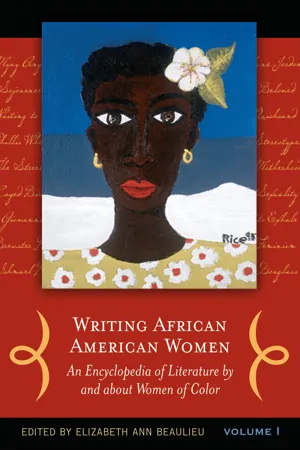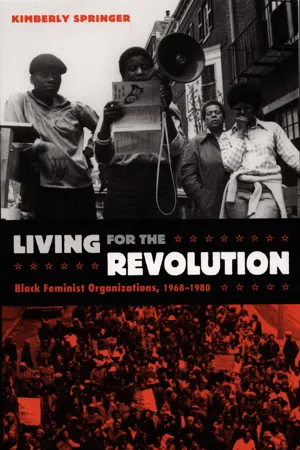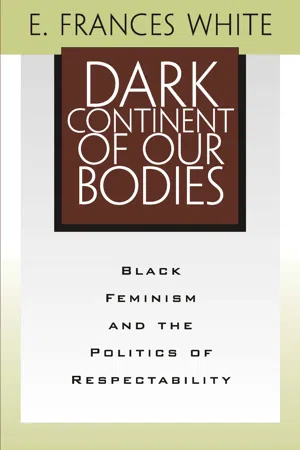Politics & International Relations
Combahee River Collective
The Combahee River Collective was a Black feminist organization active in the 1970s that emphasized the intersectionality of race, gender, and class. They are best known for their influential Combahee River Collective Statement, which articulated the need for a radical, inclusive feminist politics that addressed the unique experiences of Black women. Their work laid the foundation for contemporary intersectional feminist theory and activism.
Written by Perlego with AI-assistance
Related key terms
1 of 5
6 Key excerpts on "Combahee River Collective"
- eBook - PDF
Writing African American Women
An Encyclopedia of Literature by and about Women of Color [2 volumes]
- Elizabeth A. Beaulieu(Author)
- 2006(Publication Date)
- Greenwood(Publisher)
The Collective was responsible for two important publications. ‘‘The Combahee River Collective Black Feminist Statement’’ was widely distrib- uted in 1977 and has since been reprinted. It discusses the roots of black feminism, the basic assumptions on which the Collective based its politics, challenges and possibilities of a black feminist movement, and issues central to black feminism. A second pamphlet—‘‘Twelve Black Women: Why Did They Die?’’—was published in 1979 in response to a series of murders of black women in the Boston area. Although the Combahee River Collective is most often cited today on the basis of its publications, it also took a politically active stance on a number of issues. Consciousness raising was its most important function, especially in the early years. It defined itself as a study group that would also publish and distribute black feminist writing. A number of retreats were held to bring black feminists together, beginning in 1977. At the same time, members of the Collective worked with other groups on a number of issues, including the opposition of sterilization abuse, violence against women, and racism in the women’s movement, and the formation of coali- tions to support reproductive freedom, black women’s art, and women in 206 Combahee River Collective prison. The Collective is still recognized for its work and its revolutionary visions. See also Black Feminist Criticism Works By ‘‘A Black Feminist Statement.’’ Combahee River Collective, Boston, 1977. ‘‘Twelve Black Women: Why Did They Die?’’ Combahee River Collective, Boston, 1979. Works About Harris, Duchess. ‘‘ ‘All of Who I Am in the Same Place’: The Combahee River Collective.’’ Womanist Theory and Research 3.1 (1999): 1–26. December 14, 2003. www.uga.edu/~womanist/harris3.1. Smith, Barbara. ‘‘Combahee River Collective.’’ Black Women in America: An Historical Encyclopedia. Vol. 1. Ed. Darlene Clark Hine. Brooklyn, NY: Carlson, 1993. - D. Harris(Author)
- 2009(Publication Date)
- Palgrave Macmillan(Publisher)
10 These political penalties would appear in full force in the 1968 pres- idential contest and would hamper Democratic presidential candi- dates from Nixon onward. Democratic dominance in capturing the Oval Office would decline dramatically after 1964, with only one victory in the two decades prior to 1988. The Combahee River Collective The emergence of the Combahee River Collective at this junc- ture in history is hardly coincidental. Indeed, the Combahee River Collective (CRC), which began as the Boston chapter of the NBFO, broke off from its parent organization in 1975 to focus more exclusively on issues of sexuality and economic develop- ment. The founders of the CRC realized that the dominant polit- ical narrative excluded them, not only because of race but also because of gender. Further, the CRC founders recognized that no one would adequately contest or correct the image of the Black welfare queen. “No one” included even those groups, such as the NBFO (which will be discussed at greater length later in this book), which were pursuing agendas of inclusion for Blacks and for women. A HISTORY OF BLACK AMERICAN FEMINISM 7 Whereas the NBFO’s framework was socialist in its ideology, the CRC overtly defined itself as anti-capitalist, socialist, and revolu- tionary. During the six years of its existence, its members worked on a variety of issues that affected Black women, including rac- ism in the women’s movement. The Combahee River Collective asserted the legitimacy of Black women’s opposition to sexual exploitation and oppression, and made a major contribution to the growth of Black feminism in the United States. Its widely circulated “Combahee River Collective Statement” helped to lay the founda- tion for feminists of color organizing in the 1980s and the 1990s. In addition to the Statement, which became a seminal document of Black feminist activists, the women of Combahee also did impor- tant work focused around media exposure of Black women’s issues.- eBook - PDF
From Black Power to Hip Hop
Racism, Nationalism, and Feminism
- Patricia Hill Collins(Author)
- 2006(Publication Date)
- Temple University Press(Publisher)
Self-described as a collective of Black feminists who had been meeting since 1974, the women in the Boston-based Combahee River Collective did not reject feminism but staked a different claim in it. Grounding their feminism within Black women’s community work, the collective Is the Personal Still Political? 163 claimed that ‘‘contemporary black feminism is the outgrowth of countless generations of personal sacrifice, militancy, and work by our mothers and sisters.’’ 6 They pointed out that racism remained such a pervasive force in the lives of Black women that it limited Black women’s ability to ‘‘look more deeply into our own experiences and define those things that make our lives what they are and our oppres-sion specific to us.’’ 7 They clearly saw their work as expanding the feminist principle that the personal is political. The collective un-apologetically argued that working on their own behalf was not disloyal to the ‘‘race’’; nor did it indicate that they had sold out to White feminists. Instead, they claimed, ‘‘We realize that the only people who care enough about us to work consistently for our liberation is us.’’ 8 The collective’s members declared that identity politics constituted the most valid form of politics for them because the most radical politics came from working on their own behalf from their positions honed at interlocking oppressions that so constrained their lives. During this period of mobilization, the New York Radical Feminists, the Combahee River Collective, and similar groups that connected the personal experiences of women to a broader system of male domina-tion made invaluable contributions in heightening awareness of wom-en’s oppression. - eBook - PDF
Living for the Revolution
Black Feminist Organizations, 1968–1980
- Kimberly Springer(Author)
- 2005(Publication Date)
- Duke University Press Books(Publisher)
The Combahee River Collective The story of how the Combahee River Collective’s principal organizers became radicalized was not unlike that of other founders of black femi-nist organizations. Beverly and Barbara Smith, twin sisters raised by an aunt in Cleveland, Ohio, came to political consciousness during the civil rights movement. As high school students, Barbara and Beverly partici-pated in the school desegregation struggle in 1964. Following high school graduation, the Smith sisters volunteered with core as telephone opera-tors and canvassers in Cleveland’s housing projects. Barbara credits Cleve-land core ’s executive director, a woman and therefore a leadership anom-aly at the time, with giving her an opportunity for active politicization that might not have happened under the leadership of a male director. As Smith continued on to graduate from Mount Holyoke and pursue gradu-ate studies at the University of Pittsburgh, the civil rights movement took a turn toward black liberation politics. This articulation of a masculinist view of struggle and liberation motivated Smith’s gravitation toward the women’s movement. She explains: I went to a major antiwar mobilization in Washington, D.C., in the fall of 1969 [the National Moratorium] . . . . I thought it was the last demon-stration I’d ever go to; one of the reasons being black people back at Pitt [University of Pittsburgh] had so many nasty things to say about the fact that I was involved in what they say as a ‘‘white’’ entity, namely, the antiwar movement. There were not that many black people involved at that time and if they were, they certainly—well, I mean students are as they are— some of these people were faculty who were making these kinds of com-ments—not directly to me—but it was a very hard time to be a politically active black woman, who did not want to be a pawn . - eBook - PDF
Strange Affinities
The Gender and Sexual Politics of Comparative Racialization
- Grace Kyungwon Hong, Roderick A. Ferguson, Grace Kyungwon Hong, Roderick A. Ferguson(Authors)
- 2011(Publication Date)
- Duke University Press Books(Publisher)
Mobilizing racialized and gendered notions of black female sexual immorality that, as many scholars have noted, date back to the era of chattel slavery, the police articulate black female life as valueless and thus definitionally unprotectable. As a corrective, the Combahee River Collective mobilizes an alternative meaning-making practice that identifies the causes of these deaths: ‘‘Our sisters died because they were women just as surely as they died because they were black’’ (1979, n.p.). In linking these deaths and insisting that race and gender are the names for the processes that ushered these women to their untimely deaths, the Combahee River Collective maintains that the twelve black women were killed because their lives were not valued and, in this way, were outright extinguished. While race and gender are the names they give to the processes by which these women are rendered alien to respectability and propriety, it is the deviant sexuality attributed to them that makes their deaths ‘‘acceptable.’’ In this way, the Combahee River Collective highlights the differences within black communities, challenging assumptions of racial uniformity, discreteness, and comparability. In so doing, women of color feminism and queer of color critique situate culture as the site for the production of alternative modes of comparison and affiliation. Cherríe Moraga attests to the need for a movement that ‘‘helps her make sense of.’’ That is, Moraga does not articulate, for example, stop-ping police brutality or ensuring economic security for people of color as the organizing principles of the movement she wants, although assuredly these are struggles that such a movement may encompass. For Moraga, at base, the radical potential of such a movement comes in its ability to produce alternative meanings, alternative understandings about the nature of power. - eBook - PDF
Dark Continent Of Our Bodies
Black Feminism & Politics Of Respectability
- E. Frances White(Author)
- 2010(Publication Date)
- Temple University Press(Publisher)
This group helped to stake out a place from which black women could speak about themselves by articulating their relationship to white feminists and black liberation organizations. And the collective asserted a common experience of sexual oppression as a constant fac-tor in the day-to-day lives of black women. “Above all else,” the group contended, “our politics initially sprang from the shared belief that black women are inherently valuable, that our liberation is a necessity not as an adjunct to somebody else’s but because of our need as human persons for auton-omy . . . . We realize that the only people who care enough about us to work consistently for our liberation is us” (212). Combahee framed its political position in terms of iden-tity politics. The group declared, “This focusing upon our own oppression is embodied in the concept of identity pol-itics. We believe that the most profound and potentially the most radical politics come directly out of our own identity, as opposed to working to end somebody else’s oppression” (1981:212). Perhaps most important, Combahee recognized that its members had to analyze more than one structure of dominance at a time, and they began to speak of the simul-taneity of oppression. Black women did not suffer from sep-arate oppressions but from interrelated oppressions. I quote the collective’s now famous words: We believe that sexual politics under patriarchy is as perva-sive in Black women’s lives as the politics of class and race. 46 Chapter One We also often find it difficult to separate race from class from sex oppression because in our lives they are most often experienced simultaneously. We know that there is such a thing as racial-sexual oppression which is neither solely racial nor solely sexual, [such as] the history of rape of Black women by white men as a weapon of political oppression.
Index pages curate the most relevant extracts from our library of academic textbooks. They’ve been created using an in-house natural language model (NLM), each adding context and meaning to key research topics.





